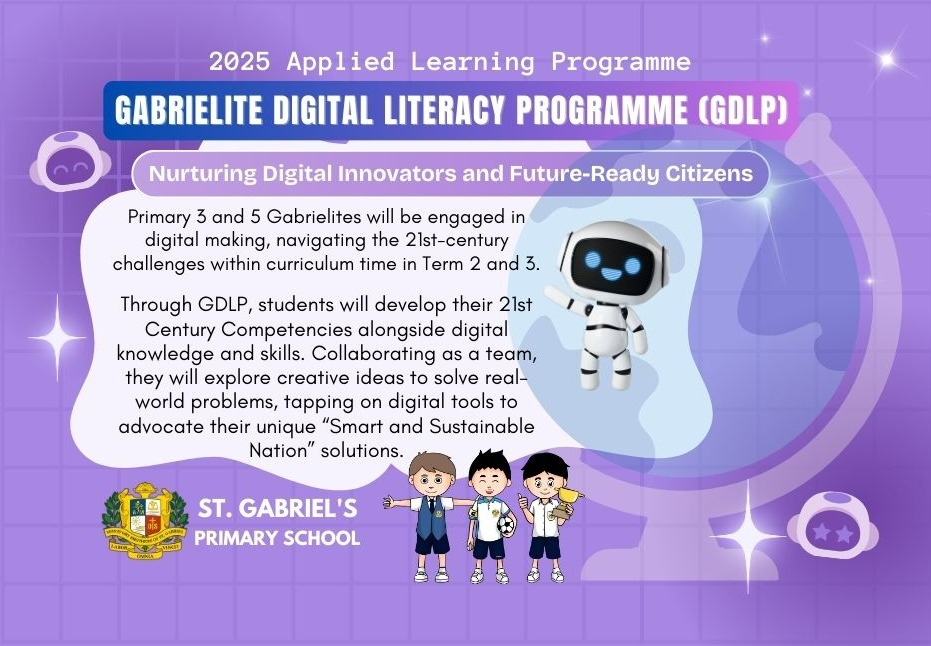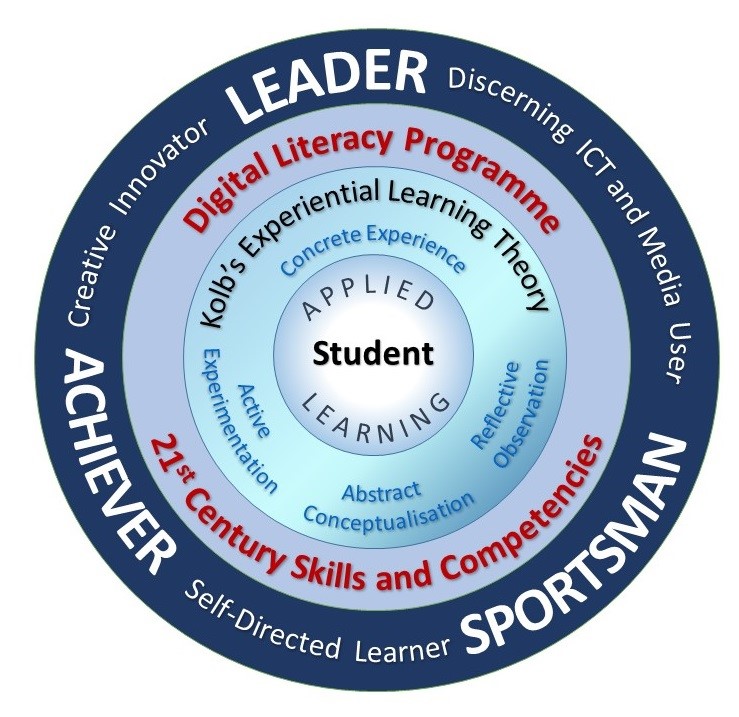Gabrielite Digital Literacy Programme (GDLP)
Vision
Nurturing Gabrielites to become digital innovators and future-ready learners
with a strong foundation of 21CC knowledge and skills.
ALP-GDLP Goals
Every Gabrielite will develop their digital literacy through Coding and
Design problem-based projects, enhancing their 21st-century skills and
competencies with Cyber Wellness values as lifelong learners and future-ready
citizens.
Applied Learning Programme Committee
Advisor
Mr Martin Tan, Principal
Key Drivers
Mrs Catherine Low, HOD Aesthetics and Applied Learning
Ms Chua Suting, SH InfoComm Technology (Internal)
Member
Mr Jimmy Tong, HOD Physical & Health Education and CCA
Mr Sean de Zilva, SH Physical & Health Education and CCA
Ms Nur Halimah, LH Student Leadership (Internal)
At St. Gabriel’s Primary School, we are committed to preparing our students to thrive in a fast-changing world. In 2025, our Gabrielite Digital Literacy Programme (GDLP) will continue to anchor students on a strong foundation of 21st Century Competencies (21CC), developing future-ready Gabrielites who are critical thinkers, creative problem-solvers, effective communicators, and collaborative team players.
As we move into an era increasingly shaped by automation and Artificial Intelligence (AI), it is essential for our Gabrielites to acquire the skills and mindsets needed to navigate complexity, ambiguity, and change. Through GDLP, students will deepen their digital literacy, enhance their problem-solving abilities, and strengthen their adaptability - all key aspects of thriving in the technology-driven age.
In line with our school’s desired outcomes, LSA 2.0 (Leader, Sportsman, Achiever), GDLP will integrate Smart and Sustainable Nation projects, offering authentic and meaningful opportunities for Gabrielites to apply their learning to real-world issues. Through these projects, students will not only develop their 21CC but also cultivate a sense of responsibility, innovation, and global awareness - equipping them to contribute thoughtfully and effectively to our interconnected world.

Click on the ‘ALP-GDLP Montage’ to capture the spirit of our young Gabrielites as they explored and accomplished the GDLP project goals together.
Introduction
GDLP is designed to equip our Gabrielites with digital literacy that will help them take on an active role in the digital world now and in the future. It leverages on the integrative approach of Coding and Design to solve real world problems. It explores the social and cultural practices of digital literacy that enable our students to make the most of their multiple interactions with digital technology and media meaningfully. It will tap into the breadth and depth of Coding and Design to deliver stimulating and engaging experiences to challenge our students to re-imagine the world around them as well as to equip them with the character and skills for the future.
Objectives
-
Nurture students to become creative and innovative learners who are digitally literate and future-ready
-
Cultivate students’ awareness and interest in coding and design through experiential and hands-on learning
-
Develop mindsets and dispositions of our students with 21st CC and cyber wellness principles
The importance of digital literacy will be emphasised through authentic learning contexts anchoring on the theme Smart Nation - Transforming Spaces for Innovation wherein students solve challenges with digital technologies. With the focus on making connected learning to the real world of design, an Applied Learning Model (Figure 1) is conceptualised and developed based on Kolb’s Experiential Learning Cycle to strengthen our learners’ Digital Literacy with 21st Century Skills and Competencies and Cyber Wellness Principles. Our learners will be involved in all the bases of Concrete Experience, Reflective Observation, Abstract Conceptualisation and Active Experimentation in the four-sage learning cycle of the Kolb’s Experiential Learning Cycle. Alignment is also made to MOE’s curriculum on National Digital Literacy Programme1 with its four components in the Find, Think, Apply and Create framework.

|
Figure 1 - Applied Learning Model: Adopting Kolb’s Experiential Learning Theory to Strengthen Learners’ Digital Literacy with 21st Century Skills and Competencies |


